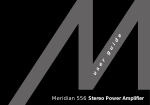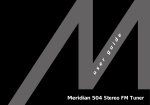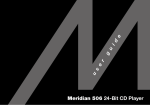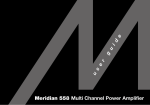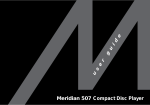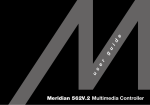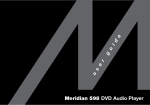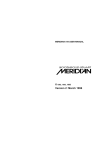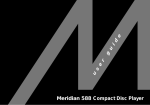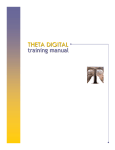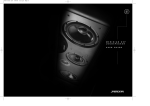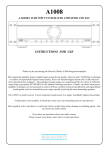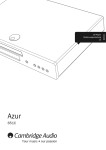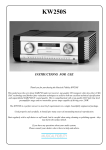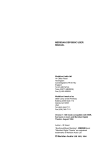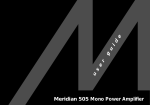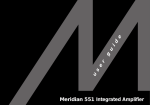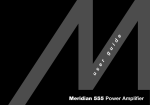Download Meridian 566 Product specifications
Transcript
e i d u g r e s u Meridian 566 24-Bit Digital to Analogue Converter Sales and service in the UK Meridian Audio Ltd Stonehill Stukeley Meadows Sales and service in the USA Cambs PE18 6ED Meridian America Inc England 3800 Camp Creek Parkway Building 2400 Tel␣ ␣ (01480) 52144 Fax␣ ␣ (01480) 459934 Suite 112 Atlanta GA 30331 Digital Gramophone and Wireless Ltd Stonehill Stukeley Meadows World Wide Web http://www.meridian.co.uk Designed and manufactured in the UK by Tel (404) 344 7111 Cambs Fax (404) 346 7111 PE18 6ED England Copyright © 1993-1997 Digital Preface Gramophone and Wireless Ltd ii Part no: 566/2 This guide was produced by Human-Computer Interface Ltd, Cambridge, England. Contents Introduction 1 Introduces the 566 24-Bit Digital to Analogue Converter, and provides an overview of the other products available in Using the Digital to Analogue Converter 7 the Meridian 500 Series. Provides step-by-step instructions on how The Meridian 500 Series ........................ 2 to operate the Digital to Analogue Sample configurations ........................... 3 Converter. Setting up the Digital to Analogue Converter 11 Front panel ............................................. 8 Describes how to unpack and install the Selecting the input ................................. 9 Digital to Analogue Converter, and Preemphasis and phase ........................ 10 explains what you should do if it requires Specification and accessories ............... 6 servicing or cleaning. Unpacking .............................................. 12 Connecting the Digital to Analogue Converter ............................................... 13 Configuring the Digital to Analogue Converter ............................................... 16 Maintenance .......................................... 20 Service and guarantee ........................... 21 Index ...................................................... 23 Preface Troubleshooting ..................................... 18 iii iv Preface Introduction In choosing the 566 24-Bit Digital to Analogue Converter you have acquired a component that combines major advances in digital audio and engineering design. The 566 24-Bit Digital to Analogue Converter provides three digital inputs and one optical input, and uses the latest 24-bit dualdifferential delta-sigma digital to analogue converter, combined with balanced Class A output amplifiers, to give extremely low distortion. This guide is designed to enable you to obtain the best possible results from the unit, whether your requirements are simply to convert the output from a compact disc transport, or to work with inputs from several digital sources. If you have just purchased the 566 24-Bit Digital to Analogue Converter, you should first turn to the section Setting up the Digital to Analogue Converter, page 11, which explains how to unpack and install the Digital to Analogue Converter correctly. The Meridian 500 Series The Meridian 500 Series is a unique system of digital, analogue, 500 Series communications and video components designed to meet the demand for absolute quality, ease of use, and lasting value. The Meridian 500 Series includes a sophisticated communications link, to ensure that any configuration of units The flexibility of the Meridian 500 Series is such that you can will work together as a fully integrated system. assemble a system as simple or as complex as you need, perfectly suited to your musical and environmental requirements, The 500 Series communications system allows you to control and which can be added to or changed at a later date should any combination of units using a single handset, and ensures your requirements change. The 500 Series is also compatible that your commands from the handset are interpreted with the existing Meridian 200 Series and 600 Series unambiguously. It also allows all the units to be switched off components. from the front panel of any unit in the system. Each Meridian 500 Series component is housed in a matching Professional features slim line case. Front panel controls provide access to the most important functions, and the full range of functions is available The 500 Series also provides features for professional users, from the Meridian System Handset using a simple and intuitive including RS232 computer control and balanced connections. control interface. The following pages give examples of four suggested Introduction configurations to illustrate the flexibility of the Meridian 500 2 Series. Sample configurations 508 24-Bit CD Player 500 Compact Disc Transport DSP5000 A500 508 DSP5000 A500 502 500 557 504 504 562 The 500 Compact Disc Transport provides a precision digital converter, providing both digital and analogue outputs. output, and can drive DSP5000 Digital Loudspeakers directly. The 508 24-Bit CD Player is ideally suited for use with the A 562 Digital Control Unit can be added to cater for conventional Meridian 557 Stereo Power Amplifier and A500 Loudspeakers, analogue sources, and provide source selection between up to with control over the volume and source selection provided by 12 different analogue or digital sources. inputs and outputs, allowing a completely balanced system to The 504 Stereo FM Tuner is an ideal addition to the system if Introduction The 508 24-Bit CD Player is an integrated CD transport and be created. radio reception is required. 3 the 502 Analogue Controller. These units provide balanced 566 24-Bit Digital to Analogue Converter 502 Analogue Controller A500 A500 500 557 Introduction 566 4 502 The digital output provided by the 500 Compact Disc Transport The 502 Analogue Controller is a full function preamplifier for use can be decoded by the 566 24-Bit Digital to Analogue Converter with any analogue source, and includes balanced inputs to allow to provide a high-quality audio output for use with a you to take advantage of balanced sources, including the conventional audio preamplifier. The 566 24-Bit Digital to 566 24-Bit Digital to Analogue Converter. It provides balanced Analogue Converter can also decode digital signals from other outputs which are ideal for use with the 557 Stereo Power sources, including LaserDisc players and Digital Audio Tape. Amplifier. 562V Multimedia Controller DSP6000 DSP6000 Satellite Video recorder 504 Television LaserDisc 500 562V The 562V Multimedia Controller is the ideal control unit for use conventional analogue sources such as the 504 Stereo FM with the Meridian DSP6000 Digital Loudspeakers. Tuner and video sound. It provides direct digital inputs for digital sources, such as the It also includes video switching for CVBS and S-VHS signals, 500 Compact Disc Transport and LaserDisc sound, together such as from a satellite receiver, LaserDisc player, or video Introduction with precision Delta Sigma Analogue to Digital Conversion, for recorder. 5 Specification and accessories Specification Outputs Unbalanced analogue output 2V nominal. Conversion Dual differential Delta Sigma, 128 times Balanced analogue output on oversampled at 2 bits per channel 2␣ x␣ XLRs. giving 24 bits resolution. Jitter Less than 1ps rms. Noise and distortion Less than -95dB. Display Illuminated legends for EQ, Lock, 44.1kHz, and Phase. Finish Black textured enamel and glass. Dimensions 88mm x 321mm x 332mm Introduction (3.46" x 12.64" x 13.07"). 6 Weight 6.4kg (14lbs). Inputs D1 – D3 digital audio, unbalanced Consumption 20VA. Meridian Audio reserves the right to amend product specifications at any time. Available accessories The following accessories are available from your dealer: ❍ Additional digital cables. ❍ Power cord Europe. ❍ Power cord Canada and USA. phono SPDIF input at 75Ω. If you have problems purchasing these items, you can order AES/EBU connection via XLR them direct from Meridian Audio Limited, who can also supply a connection on D1. range of digital cables suitable for connecting the 566 24-Bit Optical digital audio high speed Digital to Analogue Converter to other equipment. TOSLINK input. Using the Digital to Analogue Converter This chapter explains how to use the Digital to Analogue Converter, and explains the function of the front panel keys and indicators. Front panel 1 Phase Phase indicator. 2 Eq 1 2 3 Equalisation indicator. 4 3 Lock Lock indicator. Using the Digital to Analogue Converter 4 44kHz 8 BOOTHROYD STUART 566 Double lock indicator. Phase Eq Lock 44kHz D1 24-Bit Digital to Analogue Converter D2 D3 Opt Phase 5 D1 Selects digital input 1. 6 D2 Selects digital input 2. 7 D3 5 6 7 8 9 Selects digital input 3. 8 Opt Selects optical input. 9 Phase Toggles absolute phase. Selecting the input During normal use the Digital to Analogue Converter is designed Lock and 44kHz indicators to be left switched on. This uses a negligible amount of electricity, but ensures that the components of the Digital to The Digital to Analogue Converter will automatically lock to the Analogue Converter operate at maximum efficiency from the input signal providing it is in the correct range, and the Lock moment you start using it. indicator will be illuminated. If you are not going to use the Digital to Analogue Converter for Eq a period of several days you should switch the unit completely Lock 44kHz D1 D2 supply. To select the input In addition, if the input is from a 44.1kHz source, such as the 500 Compact Disc Transport, and the signal is within tolerance, ● Press the appropriate key D1, D2, D3, or Opt to select the input you want. An indicator shows the currently-selected input. double lock will be achieved and the 44kHz indicator will be illuminated. Eq Lock 44kHz D1 The digital input D1 is automatically selected when the Digital to Analogue Converter is first switched on. D2 Using the Digital to Analogue Converter off, at the back panel, and disconnect it from the AC power 9 Preemphasis and phase Eq indicator Phase The compact disc specification allows for a disc to be recorded The 566 24-Bit Digital to Analogue Converter allows you to with preemphasis, which for some types of material can give change the absolute phase of the output signal; in some lower noise levels. circumstances this can give a noticable improvement in realism. The 566 24-Bit Digital to Analogue Converter will automatically To change the phase Using the Digital to Analogue Converter correct for preemphasis on playback, and the Eq indicator will 10 be illuminated whenever material with preemphasis is being ● Press the Phase key. played. The Phase indicator is illuminated when positive phase is selected. Eq Lock 44kHz D1 D2 Setting up the Digital to Analogue Converter This chapter explains how to install the Digital to Analogue Converter. It describes what you should find when you unpack the Digital to Analogue Converter, how you should connect it to your other audio equipment, and the siting constraints. Before you begin installation, you should ensure that your Digital to Analogue Converter is the correct voltage for your local AC supply. If it is not, do not try to install the Digital to Analogue Converter, and contact your dealer. You should not make any connections to the Digital to Analogue Converter or to any other component in your system whilst the AC power supply is connected and switched on. Unpacking The 566 24-Bit Digital to Analogue Converter comes in a box In common with all digital equipment, the Digital to Analogue containing the following components: Converter emits some radio-frequency signals. Therefore, you should try to keep all power cables and network leads away ❍ 566 24-Bit Digital to Analogue Converter. from signal cables, including audio, antenna, and loudspeaker ❍ 1 power cord. cables. ❍ 1 digital cable. Setting up the Digital to Analogue Converter ❍ 1 optical connector blanking plug. 12 Radio interference ❍ 1 500 comms lead. ❍ This manual. FCC Warning: This equipment generates and can radiate radio frequency energy and if not installed and used correctly in You are advised to retain the packing in case you need to accordance with our instructions may cause interference to transport the unit. radio communications or radio and television reception. It has been type-tested and complies with the limits set out in Subpart To position the Digital to Analogue Converter J, Part 15 of FCC rules for a Class B computing device. These limits are intended to provide reasonable protection against such interference in home installations. Do not place the Digital to Analogue Converter: EEC: This product has been designed to comply with the limits ❍ In direct sunlight. ❍ Near heat sources, eg a radiator. ❍ On top of a power amplifier, as the heat generated may damage the Digital to Analogue Converter. However, it can be stacked on a 500 Compact Disc Transport, if you have this Meridian component in your system. set out in EN55013 and EN55020C. Connecting the Digital to Analogue Converter Back panel Input Description D1, D2, D3 The diagram below shows the back panel connections. Unbalanced phono at 75Ω, for use with SPDIF or AES/EBU standard signals. Digital inputs AES/EBU D1 XLR connection on D1, for AES/EBU standard signals. Note that if this input is used D1 must be left unconnected. alternative digital inputs, selectable from the front panel, and Optical EIAJ these support three different digital input standards. The Optical digital audio high speed TOSLINK input. following table gives details of the standards, and the recommended choice for different equipment: For best results with equipment providing a high quality digital output the D1, D2, or D3 phono inputs are recommended. Balanced output (R) BALANCED OUTPUT AES/EBU input Balanced output (L) BALANCED OUTPUT OFF RIGHT AES/EBU D1 LEFT ON OUTPUT L R COMMS Comms OPTICAL EIAJ Outputs D3 D2 D1 DIGITAL INPUTS Optical input Digital inputs Setting up the Digital to Analogue Converter The 566 24-Bit Digital to Analogue Converter provides four 13 Analogue outputs The sequence in which you connect the units is not important. The following two alternative audio outputs are provided: Note: Do not, under any circumstances, connect any equipment Setting up the Digital to Analogue Converter other than Meridian 500, 600, or 200 Series to the socket 14 Output Description Output Unbalanced analogue output, 2V marked COMMS on the back of the 566 24-Bit Digital to nominal, on RCA phono pair. Balanced output Balanced analogue output on XLR Analogue Converter. To connect to a 500 Compact Disc Transport connectors. To connect to other Meridian 500 Series equipment 566 24-Bit Digital to Analogue Converter COMMS 500 Series unit COMMS 566 24-Bit Digital to Analogue Converter D1 500 Compact Disc Transport DIGITAL OUTPUT Digital lead ● Connect the DIGITAL OUTPUT on the back panel of the compact disc transport to the D1 input of the 566 24-Bit Digital to Analogue Converter, using the digital lead provided. ● Connect one of the COMMS sockets on the back panel of the 566 24-Bit Digital to Analogue Converter to one of the COMMS sockets on another 500 Series unit, using the 500 comms lead provided. Alternatively, the D2 or D3 inputs may be used if preferred. To connect to a 502 Analogue Controller 502 Analogue Controller 566 24-Bit Digital to Analogue Converter CD BALANCED OUTPUTS ● Connect one of the digital inputs D1, D2, or D3 on the back panel of the 566 24-Bit Digital to Analogue Converter to the digital output of the other equipment, using a digital lead. If the other equipment provides an AES/EBU standard digital output this can be connected to the D1 input using the ● Connect the BALANCED OUTPUT LEFT and RIGHT XLR sockets on the back panel of the 566 24-Bit Digital to Analogue Converter to the balanced CD inputs of the 502 Analogue Controller, using two XLR to XLR audio leads. alternative XLR connector. Setting up the Digital to Analogue Converter XLR audio leads To connect to a DAT recorder, or other digital source 15 Configuring the Digital to Analogue Converter The Digital to Analogue Converter is initially set up so that you The corresponding indicator select the digital input you want by pressing the appropriate key will flash: Eq Lock 44kHz D1 D2 on the front panel. If you are using the 566 24-Bit Digital to Analogue Converter in conjunction with a 501/501V Control Unit or 502 Analogue Setting up the Digital to Analogue Converter Controller you can configure the Digital to Analogue Converter should select this input; for example, CD. so that it uses the COMMS signal to select the correct input automatically when you choose a particular source on the Control Unit. To configure the Digital to Analogue Converter The indicator will stop flashing. ● Press the key corresponding to the next digital input you want to configure, followed by the next source you want to associate with it, and repeat for any other sources you want to configure. ● Connect the 566 24-Bit Digital to Analogue Converter to the other 500 Series units, making sure you connect the COMMS sockets; see To connect to other Meridian 500 Series equipment, page 14. ● Switch off the Digital to Analogue Converter, using the power switch on the back panel. ● Switch on the other units in the system. ● Switch on the Digital to Analogue Converter while holding down the key corresponding to the first digital input you want 16 ● Using the Meridian System Remote, select the source that to configure; for example D2. When you have programmed all the sources you want to configure: ● Press Phase to return the Digital to Analogue Converter to normal operation, or switch it off using the power switch on the back panel. Note that you should not configure any of the analogue sources connected directly to the Control Unit in your system. Otherwise selecting one of these will change the digital input on the Digital to Analogue Converter which could interrupt a source you are tape recording. You can reset the Digital to Analogue Converter to its initial configuration using the following procedure: ● Turn off the Digital to Analogue Converter, using the power switch on the back panel. ● Turn on the power again while holding down the Phase key on the front panel. All the indicators on the front panel will be illuminated for one second. The inputs will be programmed so that they are only selected by the appropriate front panel key. Setting up the Digital to Analogue Converter To reset the Digital to Analogue Converter 17 Troubleshooting This section describes problems you may encounter when using There is no Lock light the 566 24-Bit Digital to Analogue Converter and includes suggested solutions. If these suggestions fail to cure the problem, please contact Setting up the Digital to Analogue Converter your Meridian dealer for further assistance. 18 No lights are displayed when switching on ❍ Check that your AC power supply is connected correctly. ❍ Check that one of the source indicators is lit. ❍ Check the digital connection between the Digital to Analogue Converter and the compact disc player, or other equipment. A few compact disc players, which do not conform to recommended practice, apply the digital signal to the output only when the disc starts to play. There is no 44kHz indicator ❍ Check that the ON OFF switch on the back panel is in the ON position. ❍ Check that the fuse on the Digital to Analogue Converter back panel and the fuse in the unit’s power plug have not blown; see To change the mains fuse, page 20. There is a ticking sound when the compact disc player is paused This is perfectly normal with some compact disc players, and does not indicate a fault. This indicates that the source is outside the range of the double lock. The Eq indicator flashes when there is no input This is perfectly normal, and does not indicate a fault. There is interference on the radio and/ or television when the digital converter is switched on Before following the steps below, ensure all units are switched off first. radio or television reception then the following measures should be tried: ❍ Reorient the receiving aerial (or antenna) or route the antenna cable of the receiver as far as possible from the digital converter and its cabling. ❍ Ensure that the receiver uses well-screened antenna cable. ❍ Relocate the receiver with respect to the digital converter. ❍ Connect the receiver and this product to different AC outlets. Setting up the Digital to Analogue Converter If this equipment does cause or suffer from interference to/from 19 Maintenance Cleaning To clean the connections When cleaning the Digital to Analogue Converter bear in mind The audio and digital phono connectors on the back of the that the front of the Digital to Analogue Converter is plastic, and Digital to Analogue Converter are gold-plated and need no the display panel and lid are glass. cleaning if gold-plated phono plugs are used. Otherwise, it is recommended that you unplug and reconnect each plug at least Setting up the Digital to Analogue Converter Disconnect the power cord before cleaning the unit. once a year. A proprietary contact cleaner can be used to some advantage. Note: Do not use abrasive cleaners on any part of the Digital to Analogue Converter. To change the mains fuse To clean the case, display panel, and keypad Fuse Spare ● Use a slightly damp cloth. Ensure that no water is allowed to get inside the case, and do not reconnect the power until you are certain that the Digital to Analogue Converter is completely dry. ● Remove the mains connector, and pull out the drawer next to the power input to access the fuses. Before replacing a blown fuse, if possible ascertain the cause of the failure. The fuse drawer includes a spare fuse. This should be replaced 20 by a fuse of the same rating. Service and guarantee Service Guarantee The Meridian 500 Series of hi-fi components have been carefully The 566 24-Bit Digital to Analogue Converter is guaranteed designed to give years of untroubled service. There are no user- against defects in material and workmanship for 2 years from serviceable parts inside the case, nor do the units require any the date of purchase. form of maintenance. Converter has been subject to misuse, accident, or negligence, to function correctly, it should be returned, in its original or has been tampered with or modified in any way without the packaging, to your Meridian dealer. written authorisation of Meridian Audio Limited. Attempted servicing by unauthorised people may also invalidate this In case of difficulty within the UK or USA please contact the guarantee. Labour and carriage charges are not covered unless appropriate sales and service address shown on page ii. by local agreement. In case of difficulty outside the UK or USA, contact the importing Outside the UK, local warranty liability is restricted to equipment agent for the territory. A list of Meridian agents abroad is purchased within the territory. Our agents abroad are only under available from Meridian Audio. contractual obligation to service under guarantee equipment sold through them. They are entitled to make a non-refundable No responsibility can be accepted for the Digital to Analogue charge for any service carried out on other equipment. Converter whilst in transit to the factory or an agent, and customers are therefore advised to insure the unit. This guarantee does not limit your statutory rights within the United Kingdom. When seeking service under guarantee, proof of the date of purchase will be required. Setting up the Digital to Analogue Converter The guarantee is void if the 566 24-Bit Digital to Analogue In the unlikely event that your Digital to Analogue Converter fails 21 22 Setting up the Digital to Analogue Converter Index A Accessories 6 AES/EBU input E Eq indicator F Front panel controls 10, 18 13 557 Stereo Power Amplifier 3 Analogue outputs 14 Fuse, replacing B Meridian 500 Series (continued) 8 562 Digital Control Unit 3 20 562V Multimedia Controller 5 Back panel 13 Balanced output 566 24-Bit Digital to Analogue G 14 Guarantee 21 Converter 4 communications 2 C I Indicators Meridian A500 Loudspeakers 3 the audio connections 20 44kHz Meridian DSP5000 Digital the case Eq Cleaning 20 10 Components 12 Lock Configuring Phase 16 9 Loudspeakers 3 9 Meridian DSP6000 Digital 10 Loudspeakers 5 Connecting Inputs 13 to a 500 Compact Disc Transport 14 selecting to a 502 Analogue Controller 15 Installing to a DAT recorder Introduction 1 15 Meridian System Handset 2 9 12 N No 44kHz indicator 18 No Lock light 18 to a digital source 15 to Meridian 500 Series equipment D L Lock indicator 9 M Maintenance O D1, D2, or D3 inputs Optical EIAJ input 9, 13 Outputs 14 14 9, 13 20 Meridian 500 Series 2 P Phase indicator 10 500 Compact Disc Transport 3 Phase, selecting 10 Digital inputs 13 502 Analogue Controller 3, 4 Positioning 12 Double lock indicator 9 504 Stereo FM Tuner 3, 5 Preemphasis 10 508 24-Bit CD Player 3 Index DAT recorder, connecting to 15 23 R Radio interference 12 Resetting S 17 Service 21 Setting up the Digital to Analogue Converter 11 Specification 6 T TOSLINK input 13 Index Troubleshooting 18 24 U Unpacking 12 X XLR connectors 14, 15





























